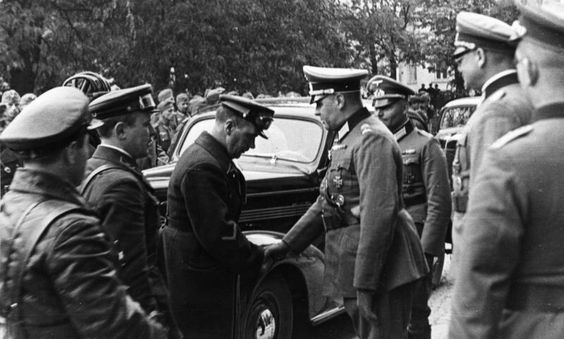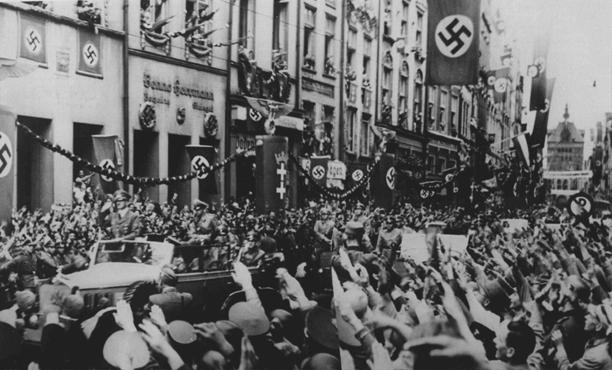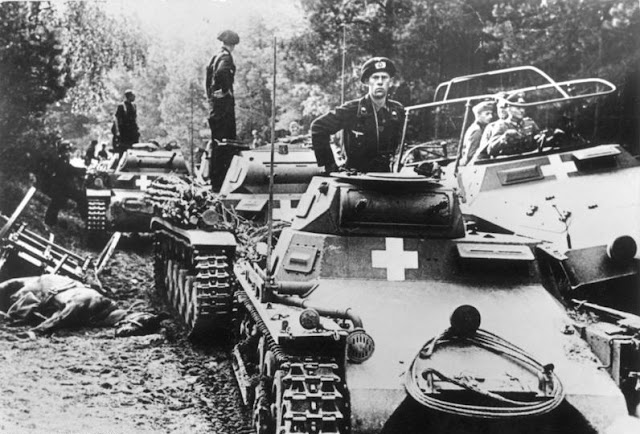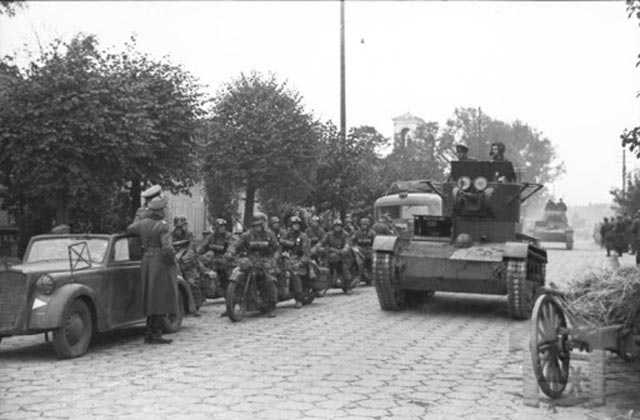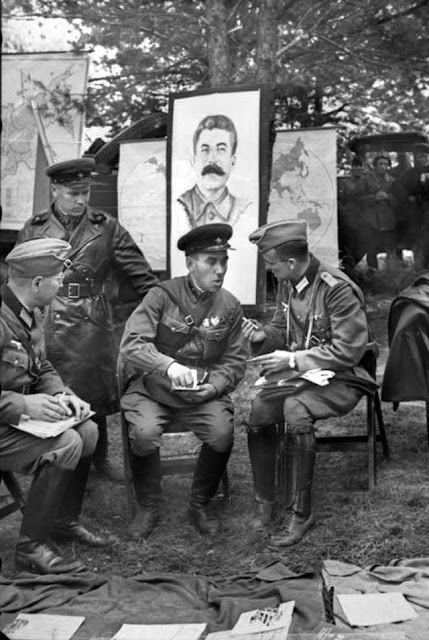Friday 22 September 1939
 |
| German and Soviet soldiers conversing, 22 September 1939. |
 |
| A Wehrmacht soldier initiates peace talks with a Russian female soldier in Brest-Litovsk, Poland, 22 September 1939. |
 |
| Guderian and Krivoshein at the Brest-Litovsk parade. |
Afterward, the German forces withdrew to the west bank of the Bug River as pre-ordained. The event has attracted much publicity in subsequent years due to the subsequent estrangement of the two forces. It is believed that the 22 September 1939 parade was the only such event that ever took place involving the two sides. Russian historians, in particular, are quick to minimize the event as being merely a "ceremonial departure" of the German forces, but the photographic record suggests that it was a bit more than that.
The Polish commander of Lwów hands it over to the Soviets.
Polish units of the 39th Infantry Division have been defending the village of Cześniki near Zamość. They have been holding off the German 27th Infantry Division and 4th Light Division. The 39th Infantry Division now is ordered to relieve Lwów and breaks through the German lines. With that city suddenly being surrendered, however, they are now on the move with nowhere to go.
"Honorary Colonel of the 12th Artillery Regiment" Generaloberst Werner Thomas Ludwig Freiherr von Fritsch is killed in Praga while "inspecting the front." He is picked off by either a sniper or a machine gun. Von Fritsch is believed to have voluntarily exposed himself to enemy fire due to his lingering disgrace over the false accusations of homosexuality used to depose him from his position as Commander in Chief of the Heer.
Western Front: The French claim to be approaching Zweibrücken in the Siegfried line. French radio also reports that the Wehrmacht has lost 150,000 men so far in the conflict. The actual figure is maybe 10% of that.
Battle of the Atlantic: The steamer Arkleside is torpedoed and sinks. A Grimsby trawler also is sunk.
Romanian Government: The government executes several members of the Iron Guard, including the assassins of the Romanian Prime Minister, in Bucharest.
Allied Supreme Command: In Hove, Sussex, the second meeting of the Allied Supreme War Council takes place between the British and French representatives. Nothing much is accomplished beyond issues of supply.
British Homefront: The Metropolitan Police Commission in London reports that road accidents have tripled so far in September. That is likely due to the blackout. The courts are clogged with blackout violations. Gasoline is rationed.
September 1939
September 1, 1939: Invasion of PolandSeptember 2, 1939: Danzig Annexed
September 3, 1939: France, Great Britain Declare War
September 4, 1939: First RAF Raid
September 5, 1939: The US Stays Out
September 6, 1939: Battle of Barking Creek
September 7, 1939: Polish HQ Bugs Out
September 8, 1939: War Crimes in Poland
September 9, 1939: The Empire Strikes Back
September 10, 1939: The Germans Break Out
September 11, 1939: Battle of Kałuszyn
September 12, 1939: The French Chicken Out
September 13, 1939: The Battle of Modlin
September 14, 1939: Germany Captures Gdynia
September 15, 1939: Warsaw Surrounded
September 16, 1939: Battle of Jaworów
September 17, 1939: Soviets Invade Poland
September 18, 1939: Lublin Falls
September 19, 1939: Germans, Soviets Hook Up
September 20, 1939: the Kraków Army Surrenders
September 21, 1939: Romania Convulses
September 22, 1939: Joint Soviet-German Military Parade
September 23, 1939: The Panama Conference
September 24, 1939: The Luftwaffe Bombs Warsaw
September 25, 1939: Black Monday for Warsaw
September 26, 1939: Warsaw on the Ropes
September 27, 1939: Hitler Decides to Invade France
September 28, 1939: Warsaw Capitulates
September 29, 1939: Modlin Fortress Falls
September 30, 1939: Graf Spee on the Loose
2020
